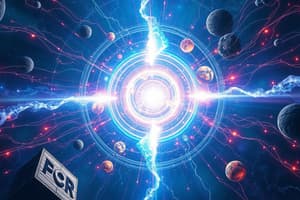Podcast
Questions and Answers
What is the primary focus of the science of physics?
What is the primary focus of the science of physics?
- The analysis of chemical reactions and the properties of matter
- The study of living organisms and their interactions
- The exploration of the fundamental principles governing the natural world (correct)
- The investigation of the human mind and its cognitive processes
Which of the four fundamental forces described in the text is responsible for the attraction between masses?
Which of the four fundamental forces described in the text is responsible for the attraction between masses?
- Electromagnetism
- Gravity (correct)
- Strong Nuclear Force
- Weak Nuclear Force
Which of the following is not a fundamental force in physics?
Which of the following is not a fundamental force in physics?
- Thermodynamics (correct)
- Electromagnetism
- Strong Nuclear Force
- Weak Nuclear Force
Which particle is responsible for mediating the electromagnetic force?
Which particle is responsible for mediating the electromagnetic force?
What is the purpose of the strong nuclear force?
What is the purpose of the strong nuclear force?
Which fundamental force is responsible for the phenomenon of electricity and magnetism?
Which fundamental force is responsible for the phenomenon of electricity and magnetism?
Which branch of physics deals with the behavior of particles at the smallest scales?
Which branch of physics deals with the behavior of particles at the smallest scales?
What is the theory that describes the fundamental laws of physics for objects moving at constant speeds relative to each other?
What is the theory that describes the fundamental laws of physics for objects moving at constant speeds relative to each other?
Which of the following is NOT a phenomenon described by quantum mechanics?
Which of the following is NOT a phenomenon described by quantum mechanics?
What is the study of the behavior of matter and energy at atomic levels called?
What is the study of the behavior of matter and energy at atomic levels called?
Which theory led to the discovery of black holes and the expansion of the universe?
Which theory led to the discovery of black holes and the expansion of the universe?
Which of the following is NOT an application of physics research?
Which of the following is NOT an application of physics research?
Flashcards are hidden until you start studying
Study Notes
Physics in Science
Physics is the science of matter, motion, and energy. It is concerned with the study of the fundamental principles governing the natural world, from the vastness of the universe to the microscopic realm of subatomic particles. In this article, we will explore various topics within the realm of physics, illuminating the wonders and challenges that come with understanding the physical world.
Fundamental Forces and Particles
Physics delves into the understanding of the four fundamental forces that govern the interactions between matter and energy:
- Gravity: Describes the attraction between masses and is responsible for the formation of structures like stars, planets, and galaxies.
- Electromagnetism: Explains the phenomenon of electricity and magnetism, which arise from the interaction between charged particles.
- Strong Nuclear Force: Controls the binding of atomic nuclei and the processes occurring within the nucleus itself.
- Weak Nuclear Force: Participates in radioactive decay processes and the synthesis of heavier elements through nuclear reactions.
These forces are mediated by particles known as bosons. Bosons include photons (electromagnetic force), gluons (strong nuclear force), W and Z bosons (weak nuclear force), and gravitons (gravity).
Classical Physics vs Modern Physics
Classical physics, developed up until about the turn of the 20th century, encompasses the motions of macroscopic objects moving slowly relative to the speed of light. It includes Newton's laws of motion, Maxwell's equations governing electromagnetism, and thermodynamics.
Modern physics builds upon classical physics but makes significant modifications to account for phenomena occurring at higher speeds and involving quantum mechanics and relativity. Two key theories emerge in modern physics: Quantum Mechanics (also known as Quantum Physics) and Relativity. These revolutionary ideas ushered in a profound understanding of nature, paving the way for tremendous advancements in science and technology.
Quantum Mechanics
At the smallest scales, particles do not behave according to classical rules. Instead, they exhibit properties of both particles and waves, leading to phenomena like superposition (where a particle exists in multiple states simultaneously) and entanglement (where particles become instantaneously connected regardless of distance).
The study of quantum mechanics yields insights into the behavior of matter and energy at atomic levels, providing a foundation for technologies such as lasers and semiconductors.
Relativity
Albert Einstein's theory of relativity, introduced in 1905, revolutionized our understanding of space, time, and motion. There are two parts to this theory: Special Relativity, which describes the fundamental laws of physics for objects moving at constant speeds relative to each other, and General Relativity, which extends these principles to include gravity. This theory led to groundbreaking discoveries such as black holes and the expansion of the universe.
Applications of Physics
Physics research stretches beyond the realm of pure scientific curiosity. Its concepts and methodologies permeate many fields, influencing advancements in communication technologies, medical treatments, environmental sustainability, and much more. For instance, understanding electromagnetism and optics has led to innovations like LED lights, solar panels, and radar systems. Additionally, research in general relativity has shaped developments in satellite navigation and gravitational wave detection.
As science continues to evolve, physics remains at its core, driving discovery and innovation. By delving deeper into the mysteries of matter, motion, and energy, physicists strive toward unifying principles that will reveal even greater truths about our world and the cosmos beyond.
Studying That Suits You
Use AI to generate personalized quizzes and flashcards to suit your learning preferences.




